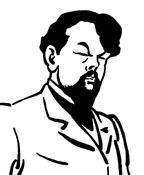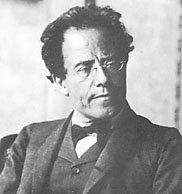20th Century Music - Giants of the Early Years by John Winiarz
/ February 1, 2000
Version française...
The coda of the 20th century is an appropriate time to
look back to the beginning of the century, when the seeds for future evolution
were being sown. In 1900, music was being written mostly by composers born in
the 1860s. In this opening article on 20th-century music we will consider some
musical giants who created a bridge between 19th-century Romanticism and the
20th-century Modern period.
Late 19th-century Paris was the undisputed cultural
capital of Europe. An established avant-garde tradition had existed there since
the middle of the century, and the assumptions of 19th-century realism were
being assailed by the symbolist poets Mallarmé, Verlaine, Rimbaud, and
Maeterlinck as well as by the post-Impressionist painters Gauguin, Seurat, and
Cézanne, who placed unprecedented emphasis on purely formal elements. However,
in spite of the progress in literature and the visual arts, French music
remained underdeveloped and strongly influenced by Germanic aesthetics.
 Claude Debussy
(1862-1918) was largely responsible for
setting French music on its new course. He was the greatest of the musical
impressionists, though he disliked this description of his music. The term
"impressionism" was derived from a painting by Monet entitled Impression: Sunrise.
But to Debussy, the symbolist poets
were more important than the impressionist painters. Nevertheless, impressionism
and Debussy are forever intertwined, for just as impressionist painters
developed new theories of light and colour, so Debussy developed new theories of
light and colour in music and attempted to capture fleeting impressions or
moods. Yet, like the symbolist poets, who developed a sensitivity of perception
with images that surpassed mere sensory observation, Debussy cultivated a
hypersensitive palette of sounds that ultimately transcended 19th century
musical rhetoric. Claude Debussy
(1862-1918) was largely responsible for
setting French music on its new course. He was the greatest of the musical
impressionists, though he disliked this description of his music. The term
"impressionism" was derived from a painting by Monet entitled Impression: Sunrise.
But to Debussy, the symbolist poets
were more important than the impressionist painters. Nevertheless, impressionism
and Debussy are forever intertwined, for just as impressionist painters
developed new theories of light and colour, so Debussy developed new theories of
light and colour in music and attempted to capture fleeting impressions or
moods. Yet, like the symbolist poets, who developed a sensitivity of perception
with images that surpassed mere sensory observation, Debussy cultivated a
hypersensitive palette of sounds that ultimately transcended 19th century
musical rhetoric.
Debussy was a natural rebel who disliked academic
composers and seldom used the sonata form, which had been dominant since
Mozart’s time. "I am more and more convinced that music, by its very nature, is
something that cannot be cast into a traditional and fixed form," he stated. "It
is made up of colours and rhythms." He found inspiration in the music of
Mussorgsky and the exotic music heard at the Grande Exposition Universelle in
1889, noting that Javanese music employed a counterpoint compared to which
"Palestrina’s is child’s play." After a brief fling with Wagnerianism, he
defiantly described himself as a musicien français.
Yet like Wagner, Debussy gave the orchestra the main task of carrying on the
drama in his opera Pelléas et Mélisande (1893-1902),
which was more of a symphonic poem with running commentary by the singers than a
conventional opera. Debussy’s harmonic method with the tritone interval
accenting drifting parallel chords, his loose tonal centres anchored by pedal
points, his outstanding sensitivity to timbre and understatement in the
orchestra, and his fluid, elastic rhythms, exerted an enormous influence on 20th
century music. His Prélude à l’Après-midi d’un faune
(1894) and the three Nocturnes (1900) established him
at the end of the 19th century as one of the greatest French composers of all
time.
Debussy’s colleague and friend, the eccentric composer
and café pianist Erik Satie (1866-1925), influenced first Debussy and then the
composers of "Les Six," a group that included Honegger, Milhaud, and Poulenc. An
essential element of French musical modernism was the rejection of German
Romanticism with its emphasis on intense personal feelings. Satie wrote, "I
explained to Debussy that I was in no way anti-Wagnerian but that we should have
a music of our own – if possible without any sauerkraut!" Composing sparse short
pieces, he proclaimed a kind of music that was sometimes anti-music. "Music
d’ameublement" was meant to be played without being listened to, like looking at
wall paper without seeing it. Satie was an early Dadaist who composed pieces
with surrealist titles such as Pièces en forme de poire
(Pieces in the form of a pear). He represented a complete break with
tradition – a conscious return to simplicity, lightness, and clarity that
inaugurated a new era in French musical life.
Vienna avant-garde
Despite its conservative core, Vienna was also a
centre of artistic activity in the late 19th century, due to a remarkable group
of radical artists and intellectuals. Here psychiatrist Sigmund Freud, architect
Otto Wagner, painters Klimt and Kokoschka, writer Hugo von Hofmannsthal, and
composer Gustav Mahler (1860-1911) were in the process of restructuring
traditional beliefs and helping to lay the intellectual and artistic foundations
of the modern age.
 Vienna’s contradictory role as a bastion of tradition and
a cauldron for innovation had its artistic counterpoint in Mahler’s complex
musical temperament. As an opera conductor Mahler’s role was to preserve the
repertoire’s masterpieces, yet his productions were considered revolutionary.
And as a composer his output betrayed similar tensions between nostalgia for the
past and a constant search for new ideas. Mahler limited himself to song and
symphony. His "symphonic song" demonstrated an expanded time scale and elaborate
orchestral accompaniment. The massive Das Lied von der
Erde (The Song of the Earth, 1907-1908) expanded the art-song as originally
exemplified by Schubert to a point where further development was impossible.
Similarly Mahler’s first four symphonies, belonging chronologically and
aesthetically to the 19th century, were all on a huge time scale. To Mahler the
symphony was a kaleidoscope calling for a mixture of styles and elements, in
which marches, folk songs, bugle calls, and grotesque parodies were combined in
an almost collage-like jumble. Mahler’s ability to take elements from diverse
sources and integrate them into a structure of unexpected significance has led
some commentators to consider him as perhaps the first truly modern
composer. Vienna’s contradictory role as a bastion of tradition and
a cauldron for innovation had its artistic counterpoint in Mahler’s complex
musical temperament. As an opera conductor Mahler’s role was to preserve the
repertoire’s masterpieces, yet his productions were considered revolutionary.
And as a composer his output betrayed similar tensions between nostalgia for the
past and a constant search for new ideas. Mahler limited himself to song and
symphony. His "symphonic song" demonstrated an expanded time scale and elaborate
orchestral accompaniment. The massive Das Lied von der
Erde (The Song of the Earth, 1907-1908) expanded the art-song as originally
exemplified by Schubert to a point where further development was impossible.
Similarly Mahler’s first four symphonies, belonging chronologically and
aesthetically to the 19th century, were all on a huge time scale. To Mahler the
symphony was a kaleidoscope calling for a mixture of styles and elements, in
which marches, folk songs, bugle calls, and grotesque parodies were combined in
an almost collage-like jumble. Mahler’s ability to take elements from diverse
sources and integrate them into a structure of unexpected significance has led
some commentators to consider him as perhaps the first truly modern
composer.
Hugo Wolf (1860-1904), a rebel who led a stormy bohemian
life, died incurably insane at the age of 43. The 242 songs that are his legacy
use a musical stream of laser-bright intensity to illuminate the poetry chosen
as lyrics. In Wolf’s songs the vocal part is often declamatory, with the piano
accompaniment featuring progressive tonality. The modulations in a four-page
Wolf song can be as extensive as those in an entire act of Wagner’s operas. And
the realism in songs like Zur Warnung (The Warning), which depicts a hangover and pushes 19th
century tonality to its limits, anticipates the expressionism in Berg’s Wozzeck.
Richard Strauss (1864-1949), the leading figure of the post-Wagnerian generation of
German composers, created a music of irresistible confidence and power – an
appropriate musical symbol for the expansionist mood of Germany at the time.
Strauss’s tone poems Tod und Verklärung (Death and
Transformation, 1889) and Ein Heldenleben (A Hero’s
Life, 1898) were brilliant compositions with noise-like effects that
revolutionized the concept of orchestral sound. In Don
Quixote (1897) muted brass play flutter-tongue in dissonant combinations to
depict bleating sheep. After 1904, Strauss produced two pivotal 20th-century
operas, Salome (1905) and Elektra (1908). Here the tonal structure was strained to
an almost unbearable level of intensity.
In his "Sketch of a New Aesthetic of Music" (1907),
Feruccio Busoni (1866-1924), the Italian pianist and composer who settled in
Berlin, staked out the principal paths that music would follow. Busoni wanted to
liberate music from outmoded practices. He proposed new scalar possibilities and
a system of microtones and even envisioned electronic instruments.
North American innovation
In North America, Charles Ives (1874-1954) was
breaking away from the European artistic mold. The vernacular of his small
Connecticut home town – hymns, popular and patriotic songs, marches and dances –
and the musical experiments of his father formed his conception of music as an
"open" art form capable of encompassing all types of music and fusing them into
a higher synthesis. Ives’s individualism is the beginning of an alternative
stream of American experimental composers who are largely unencumbered by
European precedents.
And so the seeds of 20th-century music were planted. It
remained for following generations to graft their own offshoots and cultivate
the garden.
Composer John Winiarz teaches history, theory, and ear
training in the Department of Music at Concordia University. To celebrate
International Chopin Year 1999, he recently produced a "Chopiniana" concert
featuring the première of his Lustro Szopina for
piano solo.
Sources:
Longyear, Rey M. Nineteenth-Century Romanticism in Music,
W.W. Norton & Company, Inc., New York 1973.
Morgan, Robert P. Twentieth-Century Music, W.W. Norton
& Company, Inc., New York 1991.
Schonberg, Harold C. The Lives of the Great Composers,
W.W. Norton & Company, Inc., New York 1970.
Stolba, K. Marie. The Development of Western Music, A
History, Wm. C. Brown Publishers, Dubuque, Iowa 1990.
Version française... |
|


